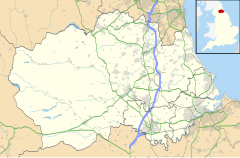Dawdon
This article needs additional citations for verification. (June 2009) |
| Dawdon | |
|---|---|
 Lumps of coal among the rocks on Dawdon Blast Beach | |
Location within County Durham | |
| Population | 7,220 (2011 census)[1] |
| OS grid reference | NZ433484 |
| Civil parish | |
| Unitary authority | |
| Ceremonial county | |
| Region | |
| Country | England |
| Sovereign state | United Kingdom |
| Post town | SEAHAM |
| Postcode district | SR7 |
| Dialling code | 0191 |
| Police | Durham |
| Fire | County Durham and Darlington |
| Ambulance | North East |
| UK Parliament | |

Dawdon is a former pit community to the south of Seaham, County Durham, England. An area of the beach near Dawdon (known locally as "the Blast", a former waste coal dumping site) was used in the opening scenes of the science fiction film Alien 3.[2]
History
[edit]The township of Dawdon (commonly spelled Dawden on old records and maps) was in the parish of Dalton-le-Dale[3] and consisted of an area of 1,088 acres between the Durham coast and the townships of Seaham, Dalton-le-Dale and Cold Hesledon. Seaham Harbour was built in the township. The port and town grew during the 19th century. In 1866 Dawdon became a separate civil parish and became part of Seaham Harbour urban district, on 1 April 1937 the parish was abolished and merged with Seaham.[4] and became part of the new Seaham urban district.[5]
"The population in 1801 was 22; in 1811, 27; in 1821, 35; in 1831, in consequence of the construction of a new harbour, it had increased to 1022; in 1841, 2017; in 1851, 3538; in 1861, 6137; in 1871, 7132; in 1881, 7714; and in 1891, 9044."[6] In 1931 the parish had a population of 19,399.[7]
Climate
[edit]| Dawdon | ||||||||||||||||||||||||||||||||||||||||||||||||||||||||||||
|---|---|---|---|---|---|---|---|---|---|---|---|---|---|---|---|---|---|---|---|---|---|---|---|---|---|---|---|---|---|---|---|---|---|---|---|---|---|---|---|---|---|---|---|---|---|---|---|---|---|---|---|---|---|---|---|---|---|---|---|---|
| Climate chart (explanation) | ||||||||||||||||||||||||||||||||||||||||||||||||||||||||||||
| ||||||||||||||||||||||||||||||||||||||||||||||||||||||||||||
| ||||||||||||||||||||||||||||||||||||||||||||||||||||||||||||
Like the rest of the United Kingdom, Dawdon has a temperate climate. At 643.3 millimetres (25 in)[8] the average annual rainfall is lower than the national average of 1,125 millimetres (44 in).[9] Equally there are only around 121.3 days[8] where more than 1 millimetre (0.04 in) of rain falls compared with a national average of 154.4 days.[9] The area sees on average 1374.6 hours of sunshine per year,[8] compared with a national average of 1125.0 hours.[9] There is frost on 52 days[8] compared with a national average of 55.6 days.[9] Average daily maximum and minimum temperatures are 12.5 °C (54.5 °F) and 5.2 °C (41.4 °F)[8] compared with a national averages of 12.1 °C (53.8 °F) and 5.1 °C (41.2 °F) respectively.[9]
The table below gives the average temperature and rainfall figures taken between 1971 and 2000 at the Met Office weather station in Durham:
| ||||||||||||||||||||||||||||||||||||||||||||||||||||||||||||||||||||||||||||||||||||||||||||||||||||||||||||||||||||||||||||||||||||||||||||||||||||||||||||||||||||||||
Dawdon Colliery
[edit]A new pit was created at Dawdon and new shafts sunk in the rocky coastal area of Noses Point, near Dawdon beginning in 1900. The colliery opened for production in 1907.
See also
[edit]References
[edit]- ^ "Ward population 2011". Archived from the original on 14 July 2015. Retrieved 8 July 2015.
- ^ "Boomtime for British film industry". Archived from the original on 18 October 2007. Retrieved 13 June 2009.
- ^ "Descriptive Gazetteer Entry for Dawdon". A Vision of Britain through Time. Retrieved 31 March 2024.
- ^ "Relationships and changes Dawdon CP/Tn through time". A Vision of Britain through Time. Retrieved 31 March 2024.
- ^ http://www.visionofbritain.org.uk/unit/10136878
- ^ History, Topography and Directory of Durham, Whellan, London, 1894
- ^ "Population statistics Dawdon CP/Tn through time". A Vision of Britain through Time. Retrieved 31 March 2024.
- ^ a b c d e f Durham 1971-2000 averages Archived 29 September 2007 at the Wayback Machine, Met Office. Retrieved on 20 August 2007.
- ^ a b c d e UK 1971-2000 averages Archived 5 July 2009 at the Wayback Machine, Met Office. Retrieved on 20 August 2007.
- ^ "Durham". CEDA Archive. Natural Centre for Environmental Data Analysis. Retrieved 25 July 2024.
- ^ "Durham (Durham) UK climate averages". Met Office. 1991–2020. Retrieved 1 January 2022.
- ^ Burt, Stephen; Burt, Tim (2022). Durham Weather and Climate since 1841. Oxford University Press. Retrieved 25 July 2024.
- ^ Tim Burt. "The weather at Durham in 2022". Durham Weather. Durham University. Retrieved 25 July 2024.
- ^ Tim Burt. "The weather at Durham in 2023". Durham Weather. Durham University. Retrieved 25 July 2024.
External links
[edit]- News stories on Dawdon: [1]
- A thousand old photos of Seaham, Dawdon and Murton: [2]
- Dawdon Colliery Remembered Archived 13 June 2018 at the Wayback Machine

